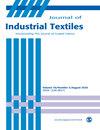新型玻璃纤维发泡非织造布过滤材料
IF 2
4区 工程技术
Q1 MATERIALS SCIENCE, TEXTILES
引用次数: 0
摘要
针刺非织造布作为烟气过滤材料得到了广泛的应用,为满足低排放要求,人们不断努力提高过滤效率。本研究采用玻璃纤维泡沫铺设和聚四氟乙烯(PTFE)乳液涂布工艺,开发了具有高过滤效率的过滤材料。分析了表面活性剂类型、纤维直径和纤维含量对玻璃纤维泡沫性能和泡沫稳定性的影响。本文首次以泡沫玻璃纤维和PTFE乳液包覆针孔非织造布为材料,对其形态、孔径、透气性、耐磨性和过滤性能进行了表征。结果与针刺非织造布和PTFE乳液涂层前的结构进行了比较。值得一提的是,与未经处理和PTFE乳液包覆的针刺非织造布相比,玻璃纤维泡沫填充和PTFE乳液包覆的针刺非织造布具有更高的过滤效率和更低的出口颗粒浓度。综上所述,通过优化泡沫成分和PTFE乳液涂布工艺,发现玻璃纤维泡沫敷设能有效提高针刺非织造布的过滤性能,有望实现商业化。本文章由计算机程序翻译,如有差异,请以英文原文为准。
Novel filter material by glass fiber foam laying for nonwoven fabrics
The needle punched nonwoven fabrics are widely used as the flue gas filter materials while continuous efforts have been made to improve the filtration efficiency in order to meet the low emission requirement. In this study, filter materials with high filtration efficiency were developed via glass fiber foam laying and PTFE (polytetrafluoroethylene) emulsion coating process. Influences of surfactant type, fiber diameter and fiber content on the foam-ability and foam stability of glass fibers were analyzed. The resulting filter materials, obtained here for the first time with glass fiber foam laden and PTFE emulsion coated needle punched nonwoven fabrics, were characterized for morphology, pore size, air permeability, wear resistance and filtration properties. The results were compared against structures obtained from needle punched nonwoven fabrics before and PTFE emulsion coating. Remarkably, compared to untreated and PTFE emulsion coated needle punched nonwoven fabrics, the glass fiber foam laden and PTFE emulsion coated fabrics displayed higher filtration efficiency and lower outlet particle concentration. Overall, glass fiber foam laying is found to be effective to improve the filtration performance of needle punched nonwoven fabrics and is promising to be commercialized after optimizing the foam composition and PTFE emulsion coating process.
求助全文
通过发布文献求助,成功后即可免费获取论文全文。
去求助
来源期刊

Journal of Industrial Textiles
MATERIALS SCIENCE, TEXTILES-
CiteScore
5.30
自引率
18.80%
发文量
165
审稿时长
2.3 months
期刊介绍:
The Journal of Industrial Textiles is the only peer reviewed journal devoted exclusively to technology, processing, methodology, modelling and applications in technical textiles, nonwovens, coated and laminated fabrics, textile composites and nanofibers.
 求助内容:
求助内容: 应助结果提醒方式:
应助结果提醒方式:


